"I believe that Powell's unashamed "parading of cinematic technique"
is something to celebrate in world cinema. For in doing so, he
captures crystallised, playful and loving visions of Britain and
the British at the time of the Empire’s imminent collapse. Black
Narcissus remains just one example of this everlasting brilliance." |
Karli Luka, Senses Of Cinema |
Have you ever seen a fully-grown leopard in a small cage? You know what tends to happen – violence directed outward, a ferocious attack at that which encloses it, imprisons it. It is a creature denied its identity. Whether we acknowledge it or not, whether we pedestal the human being as a superior creature or not, we are all animals with animal instincts and animal imperatives. We like to think that civilisation has tamed the beast but we all know how little it takes to let slip the veneer and unleash those boiling, broiling needs. You're familiar with the scorpion and the frog story? We can control our choices and our actions to some degree but we cannot escape our natures. Deny an animal its essence, its identity and no good will come of it. This is why celibacy in religious orders absolutely fascinates me. If you are a believer, you have to accept that God made you to be the animal you are and surely not to deliberately suppress your very spirit, your soul for want of a better word. For an omnipotent and omnipresent deity, God does fret a great deal about human sexuality. If he's everywhere he must be, by definition, the ultimate voyeur. What is His problem with those he created in the first place? But the idea of sacrificing a basic human instinct and believing wholeheartedly that this behaviour is practiced to serve God (what?)... OK, when it comes to on screen nuns, we are faced with mostly surreal choices. They can be sincere, asexual and po-faced (with a plethora of mountain warbling), one was in flight unaided (seriously, a Sally Field TV series), several were protecting nightclub singers in a witness protection cloister or they are, en masse, a writhing carpet of lust and debauchery. OK, I cheated. That's what Ken Russell movies do to you. Even the nuns in Father Ted were dodgy (one was a chocoholic presumably wedded to Christ so she can get her hands on his Easter Eggs). There's an ecumenical conundrum to dance to.
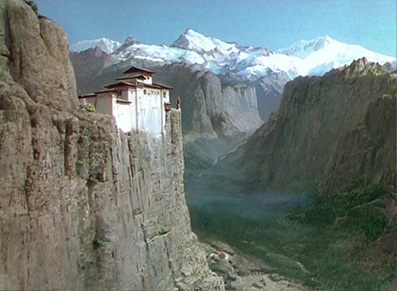
In the newspapers today, the Pope announced that 2% of priests in the Catholic Church were pedophiles (and presumably this was after the significant PR damage control button was pressed, Jesus Christ). That's not only an alarming statistic, it's more proof, if any were needed, that a cloak of celibacy and a feigned (however longed for) piety cannot contain and subdue lustful thoughts, needs and deeds. 'Honi soit qui mal y pense', indeed. A loose translation would be something along the lines of "May the horrors you imagine be visited upon you..." I did say 'loose'. But in human societies all over the world there are extreme enclaves, groups of people – like the Argentina football players of 1986 – all sharing a perverted goal. Nuns have always fascinated me because of their selfless giving in to a higher calling and yet basing their commitment on something improvable, ineffable and frankly daft. It is very obviously not seen this way by those who get the ring-tone from on high. Religion's ubiquity and antiquity is a shield against reason and rational thought. And once the vows are taken, there's no procreation, no physical abandon, well at least, not out loud. So with those undeniably sexy habits (isn't it interesting how often an adherence to a code has the opposite effect to the one intended? Kerr and Byron in this movie are frankly smoldering), the nuns maintain an even strain. They are trying to do good work in whatever area they have been charged to do so. The premise of Black Narcissus is that a small group of Anglican nuns has been sent to a remote and vertiginous, deserted palace in India to set up a school and a hospital. When there, things start to go awry. The nuns, like the British Empire, are fishes out of water and all are subject to the effect of very different people and situations that this place throws in their path. It's a sort of quasi-religious The Shining and what the Outlook Hotel and its history does to its new caretakers.
For a start, the palace used to house a harem and no one has thought to whitewash the (ahem) decorative walls. Lurid and overly suggestive statues are covered with net curtain material. The palace's caretaker is a mad, dentally challenged woman who's well aware of the effect the place has on susceptible minds, hers too presumably. The land agent (who of course is barely dressed throughout the movie) is as close to the epitome of 'a man' as it's possible to be, at least in the eyes of nuns in 1947. Chest hair blowing in the wind, his machismo is barely dented by riding a donkey about twelve hands too small for him. Competent gardener-nuns plant flowers instead of the necessary food and there's a mystical chap who says nothing but sits over the palace like the world's most inefficient security guard.
In charge of the order is Sister Clodagh played by a stunning (no kidding, just truly stunning) Deborah Kerr. She was 26 years old when she shot this movie and the character is supposed to be ten years older but the conflict within as well as without is etched upon her wonderful performance. She's a woman whose grip on her vows is not enough to conquer the many demons snickering around her including attempts to expunge the happiness of a past love life without Christ. Her opposite in character and in many ways, the antagonist of the movie, is Sister Ruth played with psychotic gusto by director Michael Powell's lover at the time, Kathleen Byron. I kicked myself for not putting two and two together. Byron was, of course, the celestial angel welcoming the airmen to Heaven in A Matter Of Life And Death. A Powell and Pressburger regular, David Farrar, plays the hirsute and rugged land agent, Mr. Dean. He looks like Stephen Mangan's more attractive older brother.
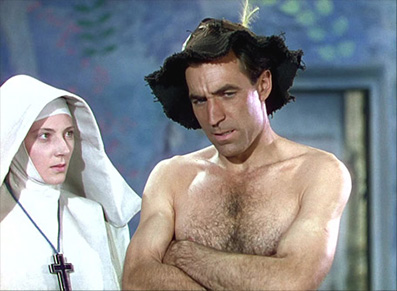
Like Oliver Reed in The Devils, he manages to be a passive catalyst to habitual carnality (sorry, but these words ask for word play). It doesn't help matters that he turns up with precious few clothes on whenever summoned by the needy Sister Clodagh. It doesn't take Sister Ruth long to mistakenly isolate Sister Clodagh as her archenemy when it comes to the affections of Mr. Dean. To emphasize Farrar's sexual allure (as if that was required given the way in which he is presented to those in the order), Powell has him arrive bare-chested at one point (not counting the hair) and while we enjoy unbridled machismo in a medium shot, Sister Ruth floats in from frame left like a sexually repressed Dalek. It would almost be hysterically funny if we knew that her slow mental disintegration would not yield fatal results. Speaking of sex (were we?) let's not forget or sideline the other sexual bomb waiting to go off. I first encountered Jean Simmons as Kirk Douglas's slave love interest in Spartacus. Here she's seventeen, Heaven help us, and an exotic temptress who seems to exude a vital and hard-wired eroticism. Ambivalent words deserve naming and shaming. 'Temptress' implies one who invites but doesn't necessarily wish to engage. Odd that the word doesn't work for the opposite gender. What man can be described as a 'tempter'? But Simmons does a great job on Sabu (one of Powell's favourite people as he reminds us several times on the commentary). She moves in, head angled for a French kiss that's going to last a day and a half... At the final second, her head falls to his shoulder. Temptress, indeed. Although she will always be Spartacus' leading lady to me, her turn in Narcissus is surprising and assured. I never found piercings particularly erotic before but that was before I caught Simmons feasting on a watermelon slice, nose ring prominent. Phew.
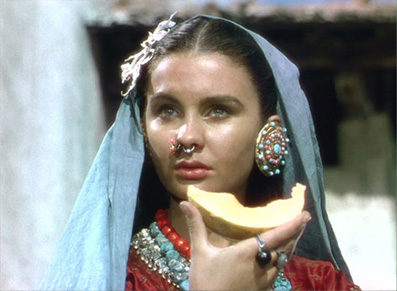
We cannot review Black Narcissus without underlining that not a single shot was filmed on any known location as metaphysical as that sounds but you know what I mean. Some scenes were exteriors but the majority of the movie was shot at Pinewood on wonderfully realised sets enhanced with playfully realistic matte paintings and some non-realistic stand-alone paintings. Powell also uses intricately scaled models and the artifice employed gives the film a rich, contained identity all of its own. However, the Palace of Mapo is in serious need of a health and safety inspection. Where are the rails around the terrifying drops? As a young man I fused the image of one of those drops into my mind as the primary representation of the film. Given the image, it's not difficult to understand. Each one of the three is arresting at the very least. Also, as a young man, I didn't 'get' Black Narcissus. I do now.
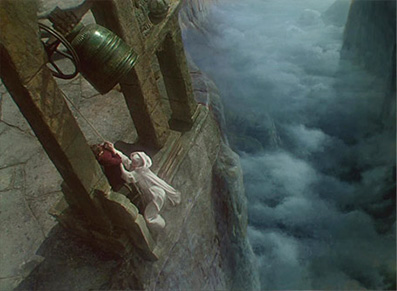
Powell initially employs dissolves (fading a shot out while simultaneously fading the next shot in) to signify a flashback. In older movies you can always tell when there's going to be a dissolve or fade to black because the quality of the film goes down by a tiny but perceptible notch (it's all about how far you're printing from the original negative). Dissolves to me are mostly lazy cuts and from my years of teaching, I can always tell a newbie editor – dissolve after dissolve after dissolve with no valid reason for such creative decisions. Ahem. This is Michael Powell we are dealing with here. On the commentary he does mention he thinks he let the dissolves go on too long. I disagree. Going back to and from Sister Clodagh's flashbacks are wonderful transitions because the visual itself is compelling. Take a look at the dissolve (before, during and after) from the fishing flashback. It's utterly sublime...

Black Narcissus is a movie where the seemingly mundane can become hugely significant and the battle between human nature and an adherence to superstition can take on extraordinary power. Stunned (as we are) to see a woman in a red dress rather than a flannelette condiment, Sister Clodagh is confronted by what she herself once was – a woman with desires and needs. Ruth's weapons and props, a violently red lipstick and a mirrored compact, presumably reflecting her real self, are brought to bear. Sister Clodagh counters with a black book created in the infancy of our species that can reflect nothing but ancient human fear and the superstitious bargains made with reason to combat them. The Bible keeps Sister Clodagh in check even though we know she is sympathetic towards Ruth. It is a talisman, a shield and to Ruth, it's something that once dropped prompts her into action.
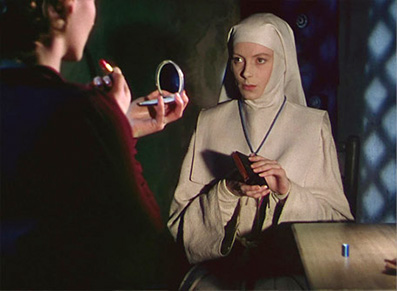
When Ruth escapes from Sister Clodagh's vigil, there's a small but lovely detail of the net curtains falling off the erotic statues, blown down from her wake... Powell was always such a master of visual metaphor.
I have to admit being utterly smitten with Black Narcissus. Its power caught me off guard and its assurance in narrative, performance, photography and direction is almost boastful. This is why there are so many frame grabs. Going through the film for this purpose had my initial tally at over 60! Grudgingly, I brought that down by half. I average 12 on any other movie. So how do these glorious images stand up on this wonderful HD format?
Taken from a 35mm interpositive, this 1.37:1 presentation looks sumptuous but then if age had not withered it, it should. Good (or in this case, exceptional) Three Strip Technicolor is a thing of rare beauty. I've yet to see any process, celluloid or digital, that can come close to match its feel, vibrancy and lushness. And in Jack Cardiff, Powell had the cameraman of camerapeople, the gentle painter whose genius complimented the talents around him. There is very little noticeable damage (tramlines or dust spots) and some colours leap out at you, 3D without the glasses. It's extraordinary how much light is required to shoot Three Strip Technicolor and how crucial the focus is at such a narrow depth of field. There were often close-ups where the eyes are out of focus and the nose is in and vice versa.
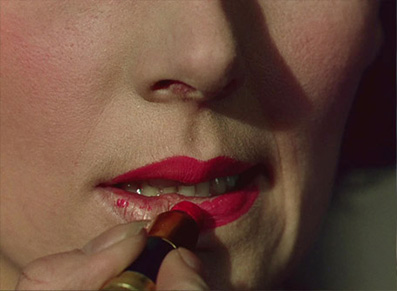
The red lipstick close up is a sensual treat (images like this influenced Martin Scorsese's use of red in Taxi Driver). The contrast range is very good with the blacks in the foreground almost (but not quite) blending with the black borders right and left. Because of the increased definition, it is possible to notice the slightly moving line between the set and the matte painting but hey, how does this detract? It doesn't.
The original mono mix rendered in PCM Stereo is fine across the board. There's very little hiss and Brian Easdale's score is rendered a tad harshly but again, it doesn't detract. There are English subtitles for the deaf and hard of hearing.
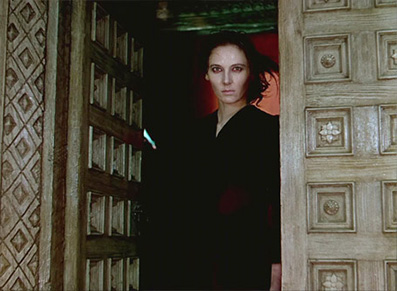
If I had to nit-pick, there are six tiny things that became noticeable on recent repeated viewings. The first is a few of the stand-alone painted shots. While the matte paintings blended with the sets strive to a sort of magic photo-realism (and boy, do they work superbly, especially the vertiginous ones), there are a few shots of just the paintings of mountains intercut with a bell ringing Sister Ruth which are obvious paintings and not blended with the live action. They break the spell just a little bit. The second and third (and these kinds of 'errors' seem common in movies of this era) fall under the editor's purview (Reginald Mills) and I'm sure he has a damn fine explanation. Sister Ruth picks up a glass of milk in a mid-shot and then in the wide, she picks it up again. Given the action cuts in this movie are almost without any kind of timing mistake, this one bugged me. At 1 hour, 27 minutes and 38 seconds in, there is the most curious line cross where Ruth suddenly appears looking at Mr. Dean to frame right while in the previous shot Mr. Dean was frame left. A modern audience wouldn't notice it. That I did tells you how modern I am and being more steeped in film craft than most is my only defence. The fourth and fifth are a pair of mistakes which I am at a loss to understand. You can only see one of the pair clearly in the frame grabs. On the top grab we see a wide process matte shot and despite the additions to the set being just perfect, something obviously went awry 'behind' the ringing bell. A matte section of the wall has been added or replaced and in being placed there, it interferes with (and lays in front of) the live action bell tolling.
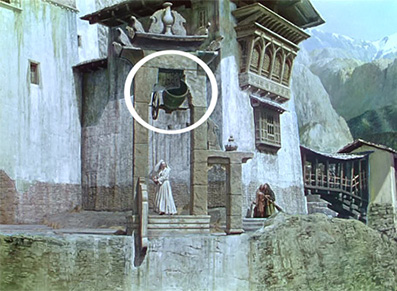
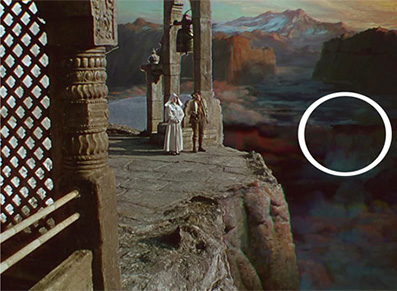
On the bottom frame grab, we see swirling colours of the valley below, an effect achieved it seems (like theatrical ones) by changing the lighting on a thin gauze screen. The matte painting gives us the side of the cliff but 'behind' the swirling colours are (wait for it) film technicians at work or is it something else? Specifically you see people moving from left to right while a couple of people stand their ground. You cannot see them in a frame grab but if you concentrate your gaze as the shot progresses you will see technicians on the set floor moving about doing their work. It is the most startling oversight in a film since I noticed the odd shapes on the front screen projections in Kubrick's 'Dawn Of Man' in 2001: A Space Odyssey. Do we care? No. Is it really bloody weird? Yes! The final and sixth issue is with the physical make up of the original interpositive itself. There is some strobing, subtle changes in the colour and contrast/brightness of the early framings that change within shots. I'm pretty sure this is a feature of the original source material and it has its distracting moments but on the whole, this problem fades as the movie moves on.
Note: Having just proofread my own novel for what seemed like the tenth time (after others had done the same) I find myself overly sensitive to typos and unfortunately, there's a howler on the Main Menu of Network's Blu-ray. This is a preview disk so with any luck the typo will be caught before the presses start churning the disks out... Apparently, Martin Scorsese and Michael Powell provide the 'commenatary' – oops.
Audio Commentary with Michael Powell and Martin Scorsese
Ported from the original Criterion Laserdisc version (1988) via the Criterion Blu-ray Release (2010), this commentary is Martin Scorsese reaffirming his passion for Powell and Pressburger's movies (never dull) intercut with Powell himself, getting on a little, which makes some of what he says a little difficult to understand. But it's a great thrill hearing him hold court knowing that his work has lasted and that it has attained some cultural significance thoroughly deserved. There are longeurs of silence (particularly galling over the one scene I wanted Powell to comment on) but this is hardly a problem. Among the gems revealed on the commentary are the following;
On his and Pressburger's independence, Powell says that if anyone in power on the outside of production suggested something that he should do, "We just said 'F' off!" which instantly reminded me of Dennis Potter's identical retort given a similar scenario. Nice to hear to how Powell accedes the Archer's writing to his partner one hundred per cent.
In a fast cut series of close ups, Powell said that this was no longer to his taste, wanting now not to call attention to the craft and championing 'art' over 'artifice'.
Of J. Arthur Rank, the distributor who literally took the movie to the US (knowing he used to be a Methodist preacher, Narcissus may have shocked him), Powell says that he probably didn't realise "...that he was carrying a live bomb under his arm."
The idea that directors Powell and Laurence Olivier were both clashing over casting Jean Simmons doesn't surprise me one bit.
Scorsese's comment of Narcissus being "...a cross between Disney and a horror film." hit home to me. Disney could be terrifying and in the art direction of Narcissus there are many references to Uncle Walt and what he was up to in the 40s.
Powell, again in a long thought through retrospection, suddenly champions cutting to the flashbacks rather than using long dissolves despite one being the best of its kind I've ever seen – see earlier.
And as for the scene when Powell gave over direction to Kathleen Byron in a moment of creative differences, the movie plays with both Powell and Scorsese silent... Ah.
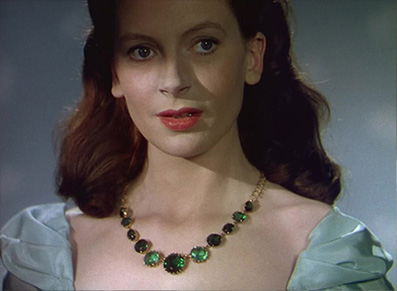
Original theatrical trailer (HD
2' 37")
And still I must keep asking as if history could answer me... Why, oh why, didn't anyone apply any drop shadow to the titles that disappear into the image behind with merely the hint of a light background. If you know the film, you could argue that there is far too much given away in this long trailer. "A high endeavour that tried and tested a woman!" It's all highly melodramatic and the print's a bit grubby but it's a great example of what was considered marketing in the late 40s. There is an extended shot of the pivotal action in the movie. It always fascinates me when footage departs from the actual movie's content. I sometimes feel like I missed out on something. It's typical for its time (all very hi-falutin') and pretty representative of the movie sans erotic subtext.
Painting with Light: a documentary on Jack Cardiff
(SD 25' 36")
A companion piece to Cameraman (which I reviewed here), this is in many ways Cameraman's older, shorter sibling. There is some commonality in material (without viewing side by side and making copious notes, I cannot be sure of what's duplicated and what's not) but there is a fair amount of overlap. Interview subjects include Jack Cardiff, Powell's widow and editor extraordinaire, Thelma Schoonmaker, Sister Ruth actress, Kathleen Byron, Martin Scorsese, past editor of the American Cinematographer magazine, George E. Turner and Archers expert Ian Christie. It seems as if the director, Craig McCall started shooting a documentary 'Persistence Of Vision' in 1998 and what resulted were many mini-pieces culminating in 2001's Cameraman. Regardless of all these versions, this is a superior companion piece to Narcissus because it's not as broad as its younger, longer brother and hones in on what Narcissus aficionados may want to know.
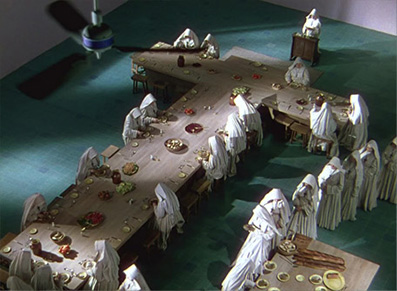
A Profile of Black Narcissus Featurette (SD 24' 02')
A solid entry for the Powell and Pressburger archives. Archers' champion, film writer Ian Christie takes us through the production of the movie with contributions from the surviving cast and crew. There are some gems in there with Kathleen Byron's husband suing Michael Powell for "alienation of affection", the crime of being more fun than he was! It must have been an interesting set as Deborah Kerr was an ex-lover of Powell's and Byron his current... Didn't make it easy for himself, did he?
Extensive image galleries (HD)
There are four choices for slide shows, each featuring scores of stills; (1) Production, (2) Behind The Scenes, (3) Portrait and (4) Promotion. It's fascinating to see such a wealth of material that staple-guns the movie and its production to a specific date – so many gaunt men in suits and ties. I've said it before but I'll say it again – the size of the blimped Technicolor camera has to be seen to be believed. Nicknamed 'The Enchanted Cottage', it's almost the same size as one.
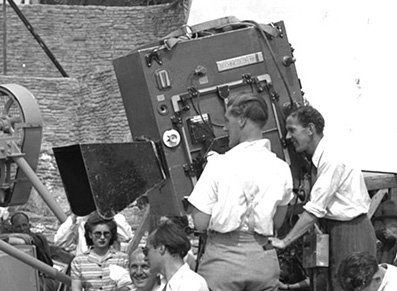
There's a shot of Farrar leaning on what looks like the bed/lounger used by the astronauts while watching BBC 11 in 2001: A Space Odyssey. What did strike me was how perfect Farrar would have been if he had been a decade younger. That uncontrollable fringe reminded me of Ian Fleming's descriptions of his anti-hero, James Bond. As a younger man (he would have been 54 when Bondmania began), he would have given Connery a run for his money. He retired from acting in 1962, the year Dr. No was released...
As for these:
Original promotional material PDFs
and Commemorative booklet
They weren't available for review.
Instant Play Facility
This is listed in the Extra Features and I am having a lovely time trying to figure out what it might mean. Are there punters out there so enamoured of the value of their time that they would not buy a Blu-ray disk unless it had a feature that enabled it to play instantly? This feature alone is worth its own comedy sketch. "Yeah, yeah... Apocalypse Now. People tell me it's a classic but does it play instantly?" Jesus.
This is a cracking transfer of a bewitching and much beloved film. If ever a movie required a high definition platform for its glorious art direction, cinematography and colour-drenched charms, it's Black Narcissus. And up against its two Blu-ray competitors (The Criterion and the ITV) it comes out joint first. If you're a real fan of great cinema and you've not seen this movie, just what are you waiting for?
|